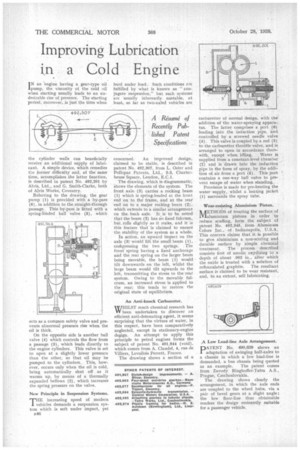Improving Lubrication in a Cold Engine
Page 56

If you've noticed an error in this article please click here to report it so we can fix it.
IN an 'engine having a gear-type oil pump, the viscosity of the cold oil when starting usually leads to an undesirable rise of pressure. The starting period, moreover, is just the time when
the cylinder walls can beneficially receive an additional supply of lubricant. A simple device, which remedies the former difficulty and, at the' same time, accomplishes the latter function, is described in patent No. 492,201 by Alvis. Ltd., and G. Smith-Clarke, both of Avis Works, Coventry.
Referring to the drawing, the gear pump (I) is provided with a by-pass (6), in addition to the straight-through passage. This by-pass is fitted with a spring-loaded ball valve (5), which acts as a common safety valve and prevents abnormal pressure rise when the oil is thick.
On the opposite side is another ball valve (4) which controls the flow from a passage (3), which leads directly to the engine cylinders. This valve is set to open at a slightly lower pressure than the other, so that oil may be pumped to the cylinders. This, however, occurs only when the oil is cold, being automatically shut off as it warms up, by means of a thermally expanded bellows (2), which increases the spring pressure on the valve, New Principle in Suspension Systems.
THE increasing speed of modern vehicles demands a suspension system which is soft under impact, yet B46
hard under load. Such conditions are fulfilled by what is known as " conjugate suspension," but such systems are usually inherently unstable, at least, so far as two-axled vehicles are
concerned. An improved design, claimed to be stable, is described in patent No. 492,307, from L. Oster and Pollopas Patents, Ltd., 2-3, Charterhouse Square, London, E.C.1.• The drawing, which is diagrammatic; shows the elements of the system. The front axle • (3) carries a rocking beam (1) which is spring-loaded at the front, end on to the frame, and at the rear' end on to a major rocking beam (2); which extends to a similar arrangement on the back -axle. It is to be noted that the beam (2) has no fixed fulcrum, but rolls slightly as it rocks, and it is this feature that is claimed to ensure the stability of the system as a whole.
In action, an upward impact on the axle (3) would lift the small beam (1), conapressing the two springs. The front' spring having a fixed anchorage and the rear spring on the larger beam being movable, the beam (1) would tilt downwards on the left, whilst the large beam would tilt upwards to the left, transmitting the stress to the rear system. Owing to the movable fulcrum, an increased stress is applied to the rear; this tends to restore the original state of equilibrium.
An Anti-knock Carburetter.
WHILST much chemical research has VV been undertaken to discover an efficient anti-detonating agent, it seems surprising that the virtues of water, in this respect, have been comparatively neglected, except in stationary-engine design. An attempt to apply this principle to petrol engines forms the subject of patent No. 491,944 (void), which comes from A. Claude], 4, rue de Villiers, Levallois Perrett, France.
The drawing shows a section of a carburetter of normal design, with the addition of the water-spraying apparatus. The latter comprises a port (6) leading into the induction pipe, and controlled by a screwed needle valve (4). This valve is coupled by a rod (3) to the carburetter throttle valve, and is arranged to open in accordance there
with, except when, idling. Water is supplied from a constant-level chamber (2) and is drawn into the induction pipe in the form of spray, by the addietion of air from a port (5). This port contains a one-way ball valve to prevent escape of water when standing.
Provision is made for pre-heating the water supply, whilst a heating jacket (1) surrounds the spray tube.
Wear-resisting Aluminium 'Piston.
lt METHODS of treating the surface of /VIaluminium pistons in order to reduce scuffing, form the subject cf patent No. 492,345, from Aluminum Colors Inc., of Indianapolis, U.S.A. This concern claims that it is possible to give aluminium a non-scoring and durable surface by simple chemical treatment. The process described consists first of anodic oxydizing to a depth of about .002 in., after which the oxide is treated with a solution of reflocculated graphite. The resultant surface is claimed to be wear resistant, and, to an extent, self lubricating.
,A Low Load-line Axle Arrangement.
PATENT No. 490,639 shows an adaptation of swinging half-axles to a chassis in which a low load-line is demanded, a bus chassis being quoted
as an example. The patent comes from Zavody Ringhoffer-Tatra A.S., Prague, Czechoslovakia.
The drawing shows clearly the arrangement, in which the axle ends are coupled to the wheel hubs, via a pair of bevel gears at a slight angle; the low floor-line thus obtain able renders the design eminently suitable for a passenger vehicle.




















































































